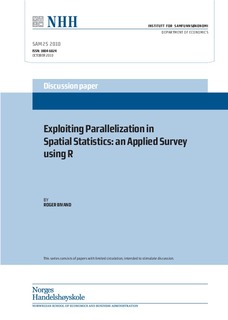| dc.contributor.author | Bivand, Roger S. | |
| dc.date.accessioned | 2011-02-14T13:23:23Z | |
| dc.date.available | 2011-02-14T13:23:23Z | |
| dc.date.issued | 2010-10 | |
| dc.identifier.issn | 0804-6824 | |
| dc.identifier.uri | http://hdl.handle.net/11250/163254 | |
| dc.description.abstract | Computing tasks may be parallelized top-down by splitting into per-node chunks when
the tasks permit this kind of division, and particularly when there is little or no need for
communication between the nodes. Another approach is to parallelize bottom-up, by the
substitution of multi-threaded low-level functions for single-threaded ones in otherwise
unchanged user-level functions. This survey examines the timings of typical spatial data
analysis tasks across a range of data sizes and hardware under different combinations
of these two approaches. Conclusions are drawn concerning choices of alternatives for
parallelization, and attention is drawn to factors conditioning those choices. | en |
| dc.language.iso | eng | en |
| dc.publisher | Norwegian School of Economics and Business Administration. Department of Economics | en |
| dc.relation.ispartofseries | Discussion paper | en |
| dc.relation.ispartofseries | 2010:25 | en |
| dc.subject | high performance computing | en |
| dc.subject | parallel computing | en |
| dc.subject | computer cluster | en |
| dc.subject | multi-core systems | en |
| dc.subject | spatial statistics | en |
| dc.subject | R | en |
| dc.subject | benchmark | en |
| dc.title | Exploiting parallelization in spatial statistics: an applied survey using R | en |
| dc.type | Working paper | en |
| dc.subject.nsi | VDP::Samfunnsvitenskap: 200::Økonomi: 210::Økonometri: 214 | en |
| dc.subject.nsi | VDP::Matematikk og Naturvitenskap: 400::Matematikk: 410::Anvendt matematikk: 413 | en |
